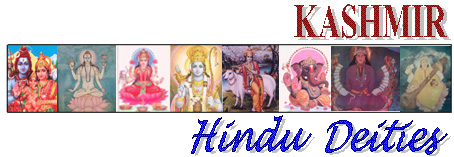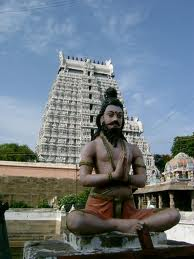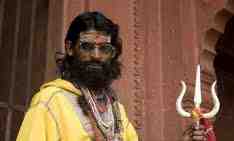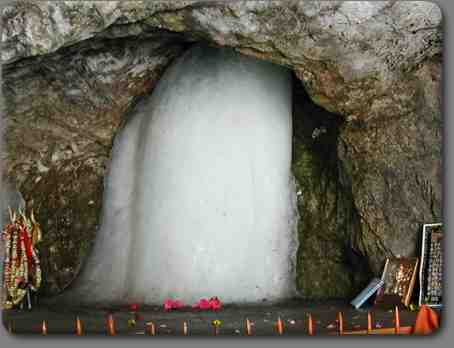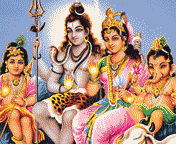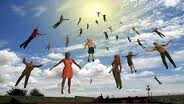|
|
||||||||||||||
| 2 Pravarasenas One Dark-Skinned, One Light-Skinned! 12th Lecture in the “Tolerant God” Series (As
Researched and Experienced by Dr. Bob Holt, MD) King Meghaváhana
Built a Village
In Kings
of Kasmira, on page 36, we read that King Meghaváhana was not interested in building a city or cities but built a
village and a monastery. This
is consistant with his being an Essene like his father Sandhimati.
"He built a village named
Meghavana and peopled it with Bráhmanas (Holy Men) and
set up a monastery named Meghamatha."
The record shows that King Meghaváhana
reigned only 34 years and then died, but our research suggests he faked his
own death and funeral, and after a time travel "vacation"
reappeared as a much older man a few days after his own funeral as
Pravarasena I. The
people never recognized him as their former king, because now he had been
crucified, and had gray or white hair, and a long white beard. King Pravarasena I, Who Ascended to God
King Pravarasena I was introduced to Kashmir as the son of King
Meghavahana in one story, yet depending on Lord Shiva to provide him with
the kingdom in other stories. Indeed the most memorable event in this king's 30 year
reign was when the people saw him ascend into the sky with Lord Shiva, and
disappear like a comet. The
city or place he appears to have been connected with was named Trigaritta.
Kings
of Kashmira page 38, "The
prince thought that the whole world was subject to him, and dedicated
Trigaritta to the god Pravareshvara which he had set up." King
Pravarasena,
"King of the World" Quite different than the picture of a poor holy man preaching one God to the "idolators", as described in the documents preserved by Muslims is the Jesus I will now present. Dressed in the finery of a rich Indian King, his robes of blue, crimson, and purple loaded with gems of every color, and chains of gold and silver. As King Pravarasena, he listened to the reports of his State Minister, Moroka. The sale of Indian spices, especially pepper, was bringing Italian gold coins into the treasury as fast as the spices could be harvested. Jewish sailors had been in control of this market since the time of King Solomon, whose ancient shrine Takhat-I-Sulaiman is still perched atop Sankarachariya Hill. King Pravarasena would arrange to have it repaired, once he could quiet the Hindu objections to the contractor Moroka, his prime minister, had found to do the work. As we will show from the most respected documents and records of the years 59 to 89 AD (by our calendar), there was indeed a King Pravarasena who ruled in Kashmir, who oddly enough thought himself to be "King of the Entire World". Once we make the connection between this king and Jesus Christ, which we will in this lecture, we will see that this was not a vain fantasy on the part of this Kashmiri king at all. History shows that if anyone at all during the years 59 AD to the present could claim to be "King of the World" it would have to be Jesus Christ. Under his banner hundreds of armies have fought, kings and emperors have been deposed, Constantine the Great, and those Roman Emperors who followed him ruled the ancient world, and since then the popes have told nations and rulers what they could and could not do. Even after the popes lost some of their power, the reformer Martin Luther still waged battle in the name of Jesus Christ. And in two World Wars the Pagan Japanese and largely atheist Nazis once more had to bow to principles once advocated by a local monarch who once seemingly only ruled Kashmir! Final
Days of the “King of Kings”
Besides the money from the spice trade, Jesus, as an Essene
“Messiah”, could and did redirect some of the temple half-shekels from
the Diaspora Essenes from Judea to India.
He would build a New Temple at Marland, or repair the temple there
already. Perhaps he would even arrange for a new copy of
the giant seven-branched candlestick to be placed there, or even a duplicate
of the Holy Ark of the Covenant.
Once some of these projects were completed, he would shed these royal
robes, or let Moroka, his prime minister wear them, and dress once more as
an Essene High Priest and holy man.
An old old man with a long white beard, and spotless white garments
down to the pavement. A
pavement kept spotlessly clean in the days of King Pravarasena and Moroka.
Pavement that now was walked on by a man even more holy than the
Jains. A man whose feet were
forever scarred by Roman nails, as he hung on a cross. His
Final Hours
There are respected references which describe all these events,
carefully kept for many centuries by people who had no real reason to lie
about them. Shaikh-us-Sadiq, Kamal-ud-Din,
p 358. "At the approach of death, he (Jesus) sent for his disciple
Babaad. He made his last will and gave directions about
preparation of the sepulcre for him, at the very place where he breathed his
last. He then stretched his
legs towards the west and kept his head towards the east and passed
away."
Quoted
in "A Search for the Historical Jesus" by Prof. Fida M. Hassnain, pg 224.
Another reference states, "And
he (Jesus) reached Kashmir, which was the farthest region in which he
ministered, and there his life came to a close.
He left the world and bequeathed his inheritance to a certain
disciple called Ababid who had served him; everything he did was perfect. And he admonished him and said to him, 'I have found a
worthy shrine and decorated it and brought in lamps for the dying.
I have gathered together the flock with the true face, which had been
scattered and for whom I was sent.
And now I shall draw breath in my
ascent from the world, freeing my soul from my body.
Heed the commands that were given to you, and do not stray from the
path of truth but keep firmly to it with gratitude - and may Abibid be the
leader.' He then bid
Abibid to level off the place for him; then he stretched his legs out and
lay down; and, turning his head to the north and his face to the east, he
passed away." From an Arabic version of the
story of Barlaam and Josaphat, The
Book of Balauhar and Budasaf (pp. 285-286). Puplished in Bombay --
Quoted from D.W. Lang, The Wisdom of Balahar, New York, 1957, p 37.
Also
quoted by Holger Kersten, Jesus Lived in India, p 228. There are slight differences in these two accounts, but no more so than the Gospel accounts of any of Jesus' activities. Babaad and Ababid are obviously two different spellings for the same person. Whether his head was to the north of his body when he died or to the east both accounts agree Jesus was facing east when he died. This will become important when we connect Jesus, as Pravarasena, with the Martand Sun temple. The east is of course the direction one must look to see the sun rise. Dying in India, were Jesus to face either Jerusalem, Mecca, or Rome in death he would have had to face westward as he died. The
Kings of Kasmira "Rajatarangini of Kahlana Pandita" The Muslim path to Jesus in India has been easy to follow, because they have made the pathway very plain for us. They want us to see Jesus as a Muslim saint, although Mohammed will not be born yet for 5 centuries after Jesus passed on. At the least they hope we will see Jesus as a worshipper of Allah, of the "One God" of Islam and Judaism, which it turns out was not the face he turned towards his new followers and soon to be subjects as King Pravarasena of Kashmir. The Muslim trail is clear to them, but only partly true. To learn the whole truth will require some detective work and some real background knowledge of Jesus the Essene. The man who coached his son-in-law, the Apostle Paul to say, in 1 Corinthians 9:22 b "I am made all things to all men, that I might by all means save some." The truth of the matter is, Jesus had no problems at all relating to Hindus and Buddhists, because he shared their love towards their fellow men and their desire for religious liberty. Now we shall read the oldest and most reliable history of the Kings of Kashmir, and see Jesus portrayed, if not clearly, at least in an identifiable fashion. Kings of Kashmiri, Jogesh Chunder Dutt, 1979 Ed., page 37, "He (Meghaváhana) was succeeded by his son Shreshtasena who was also known as Pravarasena and also as Tungjina. He set up the images known as Mátrichakra and Pravaraeshvra, and several other images in old places." We already see we have difficulties to surmount here. This king has three names to start with, and none of them resemble Saint Issa, Yuz Asaph, or Jesus. However, in both cases we have three names, not one, so that is a start anyway. Jesus' fathers, according to the New Testament, were Joseph and God, depending on whether you believe in "virgin birth". Here we have another father named Meghaváhana. And Pravarasena starts his kingship by erecting or repairing and displaying a number of images, making him a Muslim "Antichrist" right from the start! Before we throw up our hands in total despair, however, we go to the next sentence, which reads: "The prince thought that the whole world was entirely subject to him, and dedicated Trigartta to the god Pravareshvara which he had set up." As we mentioned before, there has been no single person who could claim to rule the whole world since 59 AD any more than Jesus Christ, if indeed this is who we are talking about here. And so we will read on further. "He ruled over other kings, and reigned for thirty years with mercy." The very shortness of this account speaks well for our identification with Jesus. Surely if Jesus as Pravarasena had started a war or waged a campaign, this book would tell us so. So evidently he did none of this. Yet he ruled over other kings. How? They must have submitted to his rule voluntarily. And there we see it, "with mercy".--consistent with the one who said in the Gospels, "Come unto me, all ye who labor and are heavy laden, and I will give you rest. Take my yoke upon you, and learn of me; for I am meek and lowly in heart: and ye shall find rest unto your souls. For my yoke is easy, and my burden is light." Matt. 11:28-30. Evidently a lot of people, including kings, took him up on this offer for thirty years. Lastly, we read, "He always liked to use his jewelled sword." That's it. Next we're reading about his sons who replaced him after thirty years' reign! However, even this queer little verse, "He always liked to use his jewelled sword."-- is a hint we're talking about Jesus. Use it for what? Certainly not for chopping off people's heads, or the author would have said so. He enjoys going into great detail about such things in the rest of his book! Not in leading the people of Kashmir into battle. Not a single battle is described, and our author likes to describe battles also. The only thing left is for display. One doesn't take a jewelled sword into battle, anyway. Any old piece of steel with a sharp edge can be used to kill people. We remember another verse in Revelation, "And I saw heaven opened, and behold a white horse; and he that sat upon him was called Faithful and True, and in righteousness he doth judge and make war." Rev. 19:11 Heaven is here Kashmir, called "Paradise" even in the olden days. And a king who can rule here for thirty years "in mercy" fits the description of Rev. 19:11 exactly. Next we read in verse 12, "His eyes were as a flame of fire, and on his head were many crowns;…" The prince who "ruled the entire world" of "The Kings of Kasmiri". Now watch this, "…and he had a name written, that no man knew, but he himself." There's your hidden identity, a man with six names, most of them unknown to people of our generation, the ultimate readers of Revelation 19:12. Now for that jewelled sword. "And out of his mouth goeth a sharp sword, that he should smite the nations: and he shall rule them with a rod of iron: and he treadeth the winepress of the fierceness and wrath of Almighty God." Revelation 19:15 All we really see of this fierce picture of Revelation is that line saying, "He always liked to use his jewelled sword." But the picture of God here is the picture of Shiva, the potential judge and destroyer of the world. How can we connect the mild and gentle Jesus with Shiva? In the Muslim picture, never. In "The Kings of Kashmiri" picture, very clearly, in Appendix E, with a curse for our author for being so devious!
Jesus
as a Devotee of Shiva Although it is far from obvious to start with, Appendix E, on page ix after page 303 is also about King Pravarasena. This becomes obvious only two thirds of the way down the page which states, The death of King Pravarasena is thus told." One now has to go back and endure the first part of the page with its unclear writing and abysmal grammar and realize that we're getting answered all our problems connecting Jesus with King Meghaváhana. Actually in this story Jesus is not Meghaváhana's son, but was made king by Shiva himself. As the story shows as it takes its devious way through our bewildered consciousness. "The visit of Shiva to the king is thus narrated: At Shri hill the prince met a follower of Shiva named Ashvapada, who gave him some roots, etc, to eat and said that in a former birth he (Ashvapada) had attained perfection and had asked the prince what he wanted, and the prince had asked to have a kingdom." This may be referring to the fact that Jesus, as a Messiah of the Essenes from 29-33 AD, had never really ruled a kingdom. Now that Jesus was here in Kashmir, the prophet sent by Shiva could refer to that "other life" in which they (Jesus and he) had had this former conversation. "And when I was thinking as to how your desire could be attained, Mahádeva said to me that you were his favored follower, and that he would fulfill your desire. Thus saying, Mahádeva disappeared. " Evidently, "Mahádeva" is a vision or apparition of Shiva, possible easy for Indians to see, but hard for us westerners.
"These words reminded the prince of his former life, and with a desire for getting the kingdom, he worshipped Shiva for one year, after which period Shiva appeared to him in the form of a hermit, and promised to give him whatever he wanted." We can learn three things from this sentence. That Jesus was to change his religious beliefs. That he had a probationary period to do this (one year). And then he underwent a testing quite similar to that in which he was "tempted by Satan" in three of the Gospels. But this time the hermit is "Satan". "Again, the devil taketh him up into an exceedingly high mountain (the Himalayas), and showeth him all the kingdoms of the world, and the glory of them; And saith unto him, All these things I will give thee, if thou wilt fall down and worship me." Matt. 4:8,9. Jesus, in this Hindu story, is willing to do just that!
"The
prince wanted to be king of the world." Exactly what he
later thought he was as described in the short version on page 37-38!
"Wherefore do you ask.'
Questioned the god in the form of a hermit, 'temporary enjoyment instead of
salvation.?" This is a
rather obvious reference of Solomon's wiser choice of wisdom instead of
power and money. As recorded in 1 Kings 4:5, 13.
In which God gives him both the wisdom and the power and money.
But Jesus, as in the Gospels, is able to out talk and outwit even
Shiva, and is rewarded for his cleverness. "The prince answered. 'I asked you for the kingdom believing you to be a false hermit, for surely you are not Shiva, the great guru of the world. For the great give more than is asked of them, they will give milk if a thirsty man asks for water. You cannot know the pain which I feel for not getting salvation.' Shiva became glad, and showed his real person to him and said that 'in due course, when you will be reigning, Ashvapada by my orders will warn you of your salvation,' When Shiva disappeared, the prince took leave of Ashvapáda and came to Káshmira." Obviously, if Pravarasena was actually the son of the former king, all this would have been unnecessary. He would have become king on the death or abdication of his father, not be reduced to begging Shiva disguised as a hermit for kingship after a year's probation as a devotee of Shiva. Riding
Off into the Sky in a UFO! As we continue reading Appendix E of The Kings of Kasmira (after page 303) we know for sure we are reading about King Pravarasena of Kashmir because the next verse says, "The death of King Pravarasena is thus told." Once again this is a bit devious because no death is described, just an ascension as Jesus is described as making in the Gospels and Acts of the New Testament Bible, or in more modern terms, a ride aboard a UFO! "By the orders of Shiva, Ashvapáda addressed one Jayanta, Káshmirian Bráhmana, saying, 'I hope you are not weary of travelling; show this letter to the king.' But the Bráhmana said that he was weary of traveling, and could not set out that day. Whereupon Ashvapáda replied that he was a hermit of the class that carried human skulls, and as he had touched him, he should bathe." Let me interject here such bathing after touching a dead body is an important part of Mosaic law and Essene regulations. "So saying he pushed the Bráhmana into a pond. Rising from the water (now baptized), when Jayanta opened his eyes, he saw himself in his native country, and the servants of the king busy fetching water from the river for the king to worship." Worship who? Shiva of course!
"Jayanta found opportunity
to put the billet hastily in one of the water-vessels.
Now, when the king was bathing Shiva Pravaresha (showing Shiva as
the God to which he had earlier dedicated Trigartta), the letter dropped from the pot, he read it, and sent for Jayanta whom
he dismissed with royal presents. The
contents of the letter were as follows; --'You have done what should have
been done, you have given large gifts, and enjoyed what should have been
enjoyed, your years are on the decline, what more shall you do?
Come to the home of Shiva.'"
"The king ascended the
heaven piercing through the stony house and the people saw him going towards
Kailása across the clear
sky, like another sun. The
king reached the court of Shiva in his human body.
Even to this day may be seen the passage through which the king
made his exit into heaven. Jayanta who got riches by this strange means, built a village
inhabited by Bráhamanas,
and called it after his name."
is seen as a Shiva Lingam, and is visited by devotees. It seems appropriate that something that waxes and wanes like this ice column should represent a god who is cyclic, like CREATION. King Hiranya and the "Potter's House"
Hiranya was probably a nickname of Jesus' oldest son by Lydia of
Thyratira. Har means
"mountain" in Hebrew, and "Haran" means mountaineer.
Vowels don't count in Hebrew, so Haran and Hiran would be the same
word, and the -ya just makes it Indian. To Jesus' other sons, Jesus Justus
in Judea, and Joses the Rama-Theo later to live in France, the next son,
Lydia's oldest son, would be the "mountaineer" because he lived in
Kashmir, in the Himalayas.
Kings
of Kashmira has absolutely nothing to say about the reign of Hiranya
except he reigned for thirty years without having a child to succeed him.
Oh yes, it is said that he imprisoned his brother for circulating
coins he didn't like, but we can discount this entire story as Essene
editing in "Gospel Pesher" for reasons we will get into in just a
moment. I am going
to assume Hiranya married an Essene girl from Israel about the time he
became king. The girl
turned out to be barren, like Sarah wife of Abraham, but Hiranya loved her,
and refused to take another wife.
Essene custom was one wife only, but generally the men would not
marry the women until they were pregnant.
Evidently Hiranya did not take this precaution.
I think we can assume Hiranya was a Jewish Essene and a monotheist,
because he is not described as building any images and worshipping them. The Strange
Story of Toramána
Explained
First let's just relate the story as it was copied out of the old
records by Kahlana Pandita, perhaps with a bit of literary flourish, but
essentially what certain Essene scribes wanted him to relate.
Don't be perturbed by the irrationality of this story, we'll explain
it.
Page 38. "Of his (Pravarasena's)
two sons, Hiranya became king, and Toramána assisted his brother in the
administration of the kingdom. Now
the latter forbade the use of the coins struck by king Vála, and largely circulated the
Dinnaras coined by himself. This
brought on him the king's displeasure, who looked upon it as a mark of
disrespect towards himself, and imprisoned his brother.
Toramána's wife Augjaná,
daughter of Vajrenda of the line of Ikshaku, shared her husband's
confinement, and in the prison she became pregnant.
In the fullness of time she was secretly delivered of a boy in a
potter's house, being ashamed of publicity.
The potter's wife brought up the child, its real parentage being
known only to her and to its mother.
And at the mother's request the child was called by the name of its
grandfather, (father's father)." The
grandfather's name would be Pravarasena I, of course, so we are talking
about the childhood of Pravarasena II, later the great warrior and city
builder .
Since the "Potter's Field" in the Essene "Gospel
Pesher" used at Qumran and in the Wilderness of Judea referred to the
Qumran area and the caves in which the Dead Sea Scrolls were buried, I think
we can safely presume an Essene village near Shrinagar was the
"Potter's House" in which Toramána
and his wife Auganá lived. And it is likely the
village named Meghavana, built by King Meghaváhana,
was an Essene "ghetto" of which quite likely no trace
remains.
There follows in Kings of Kashmira, a long series of
stories about Mátrigupta,
who was appointed ruler of Kasnmir by the powerful overlord
Vikramáditya,
who was later deposed by the grandson of Pravarasena I.
Who I have decided is really Jesus Christ. The "New Jerusalem" Comes to Kashmir!
Were it not for a few sentences in the story of King Lalitadita of
Kashmir, recorded in Kings
of Kashmira by Kahlana Pandita we might not know about Jesus'
"New Jerusalem". The
real one, that is. King
Lalitadita was the great king who built (or rebuilt) the Martand Sun Temple,
and several other structures of the same ornately carved stone in the
Kashmir area. Although
the structures this king built were beautiful, they were no equal to an
entire city built by King Pravarasena.
The story of King Lalitadita's jealous drunken rage is recorded on
page 77. "Once,
when dwelling at Parihasapura in the company of his women and intoxicated
with wine, he told his ministers that if they wished to increase the beauty
of his city, they should burn Pravarapura,
the city built by king Pravarasena.
His orders could not be disobeyed, and the ministers hurried to the
place and set fire to the dry grass and heaps of grain at Vatulanaka.
The king saw from his palace the burning flames and laughed loudly.
Even a good man, when filled with envy, sees things belonging to
others, as more plentiful then they really are; as the eye afflicted with
Timira sees moon etc double. For if it were
not so, why should this king, who built numberless cities, consider the
single one built by Pravarasena to be fit to be destroyed. But when he became sober he grieved at the sin committed in
burning the town --- On the morning, when his ministers saw him repenting,
they removed his grief by assuring him they did not burn the town." A Very Unusual
City!
We discover in Kahlana Pandita's kings list that Pravarasena II
reigned from 125 AD to 185 AD, a very long reign of 60 years.
Surely he had time to build a city and name it with his own name.
Search of the records show that indeed he did.
But the records also show that his grandfather, Pravarasena I had
already built a city still in good condition after at least 36 years,
perhaps longer. Page 52 "After
conquering the world, he lived in the city raised by his grandfather, but
felt a desire to found a city in his own name."
Subsequently the city built by Pravarasena II was built, but not
until the king was shown exactly where to put it by a giant apparition who
allowed the king to cross the river on his leg, which doubles in this
account for the "stairway to heaven" stories of Jacob, Jesus, and
Mohammed. In this version
Pravarasena II carves steps in the flesh of the Rakahasa to cross the river. The story is in Appendix F page x. In any event, if the second Pravarasena built the city
still standing in Lalitaditya's time, it might still be standing, 500 years
old by then. It must have been
built of pretty durable materials, perhaps metal and stone, since fires are
common. Perhaps the later
attempt to burn it down was a real attempt, and the burning grass and grain
found nothing to ignite! A
City that Won't Burn!
The Bible Version. Revelation 21:2 "And I John saw the holy city, new Jerusalem, coming down from God out of heaven, prepared as a bride adorned for her husband. 2 And I heard a great voice out of heaven saying, Behold, the tabernacle of God is with men, and he will dwell with them, and they shall be his people, and god himself shall be with them, and be their God."
Revelation 21:4 "And
God shall wipe away all tears from their eyes; and there shall be no more
death, neither sorrow, nor crying, neither shall their be any more pain: for
the former things are passed away."
What has indeed "passed away" is the former Jerusalem,
and King Herod's great temple. In
the Roman siege of Jerusalem there was indeed much death, pain, sorrow, and
crying. And in the
subsequent siege of Masada King Pravarasena (as Jesus of Gennesareth) may
have watched one of his own sons crucified by the Romans (Jesus Scroll by Donovan
Joyce, 1973). The "New
Jerusalem" in Kashmir built by Pravarasena (or Pravarasena II) will
replace the former Jerusalem, and last at least 500 years, maybe much
longer.
Revelation 21:10 "And he
carried me away in the spirit (riding in a UFO) to
a great and high mountain (the Himalayas), and
shewed me that great city (Pravarapura), the holy Jerusalem, descending out of heaven (Kashmir) from
God, (Sandhimati, Pravarasena, and their descendents)---11 Having
the glory of God: and her light was like unto a stone most precious, even a
jasper stone, clear as crystal; 12 And had a wall great and high (the mountains
surrounding the valley of Kashmir), and
had twelve gates, (twelve
signs of the Zodiac), and at the gates twelve angels (the twelve Elohim), and
names written thereon, which are the names of the twelves tribes of the
children of Israel (the Essenes of Qumran and the partly Jewish
inhabitants of Kashmir)."
Revelation 21:18 "And the
building of the wall of it was of jasper: and the city was pure gold, like
unto clear glass. 19 And the
foundations of the wall of the city were garnished with all manner of
precious stones --- 21 And the twelve gates were twelve pearls; every
several gate was of one pearl: and the street of the city was pure gold, as
it were transparent glass. 22
And I saw no temple there: for the Lord God Almighty and the Lamb are the
temple of it."
Kings
of Kashmira page 53. "In
the village of Sharitaka Pravarasena proposed to build a city. But before he did so, he wished to set up Pravareshvara
Shiva, and he employed artisans for the purpose.
But an image of Shiva sprung up from the ground from among the
instruments of the workmen, and it was named Jayasvami from Jaya the name of
one of the sculptors." (I
think we can safely presume Jaya the sculptor made the statue).
"The god Vinayaka
Bhimasvami who faced
towards the west, without any human agency turned himself and faced towards
the east, for the welfare of the intended town." (This
may indeed have been done by Jesus on one of his "saucer trips" to
signify Rome, Israel, and the Middle East no longer was where help would
come from. Help would
come from the rising sun so long as the sun should last.
The clue: Jesus himself, as Hazrat Issa, faced towards the east as he
lay dying.)
Page 53 continues. "The
king further set up images of the five goddesses Sadbhavashri and others
each having shri after her
name." This signified
the Age of Aries, and of Ra-Marduk, the hater of women and goddesses was
over. "He caused to be built a large bridge of boats on the Vitasta, and
from that time the bridge of boats became
known to the world." Evidently
the boats were replaced regularly, and repairs made when necessary.
Such a bridge would last literally "forever".
"His maternal uncle
Jayendra built a large Buddhist vihara named Jayendra vihara after his
name." Showing that Pravarasena II was totally at ease with
Buddhists, as well as Hindus and Essenes.
"And his minister Moroka, who ruled Ceylon, built a beautiful house
named Morokabhavana." Here is a hint of both continued flying
saucer commuting, as well as time/space displacement, another capability of
the "new technology".
How could Moroka rule Ceylon, a very long ways from Kashmir, and
still enjoy a beautiful house in the "New Jerusalem" in Kashmir?
Answer: The same way Sandhimati had maintained his position as an
Essene "Royal Messiah" at Qumran while he was also ruling as a
("celibate") king in Kashmir.
And the same way that Jesus as possibly
Meghavahama, and for sure Pravarasena had done the same thing.
For other related information points to Moroka as none other than
John Mark, Jesus' earlier valet at Qumran.
If indeed Kahlana Pandita has his facts straight here, and Moroka is
now serving Pravarasena II instead of Pravarasena I, then he has been picked
up by a flying saucer in one time era, and set down in another time era, and
given new duties with Jesus' grandson.
Perhaps fifty years after he should have died by conventional
reasoning. Marking down
all these strange happenings at which no Hindu would even raise an eyebrow,
I don't think this wonderful transplant of a person from one era to another
would bother Kahlana Pandita one bit!
Page 53 continues, "The
new city which was enlarged by Vishvakabhamma and Soma, was raised on the
southern bank of the Vitasta, and contained thirty six lacs of houses, it
contained several market places, and its high houses touched the clouds,
from whose tops, in the rainy season the earth could be seen drenched with
rain; and in Chaitra sprinkled with flowers.
In this city alone the rows of the houses of amusements were built
just on the river, and the hill of recreation was in the center of the town,
from whose top the whole city could be seen.
In the hot season the inhabitants of the city could get the cool
waters of the Vitasta at their doors.
And the royal gifts to the gods of the city were so rich, that they
could buy the world a thousand times. The
forehead of the king was marked with the sign of the sula
over which his white hairs flowed like the Ganges on the head of Shiva.
Thus reigned Pravarasena for sixty years."
|
||||||||||||||
|
If you have read the above SUMMARY of the Kashmir traditions of LORD SHIVA and at least SOME of the eight topics with LINKS above, you MIGHT be ready for SOME or ALL of the TOPICS with links below (Definitely HERETICAL to most!) JESUS as a DEVOTEE of LORD SHIVA!
|
|
For even more incredible stories of Jesus in Kashmir CLICK ON ANY OF THE LINKS BELOW: CROSSOVER CODES 1 FAMILY, 3 CRUCIFIXIONS CRUCIFIED AT MASADA
|
